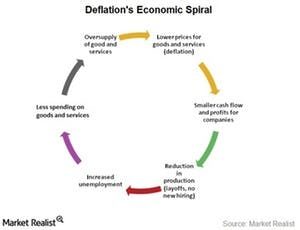
Curreny warfare is a way to export deflation.
When one country weakens its exchange rate, another country’s exchange rate gets stronger. This makes imports cheaper for the country with the strengthening currency. A flood of cheap imports in its markets hampers inflation. Inflation is boosted by increasing domestic demand. The increasing domestic demand is backed by price competitiveness.
Now, the availability of cheap imports is detrimental to domestic producers. The producers are forced to reduce their prices in order to maintain their market share. Lower prices weigh down inflation. A persistent reduction in the general price level, also known as “deflation,” creeps into the economy.

As you can see in the above graph, deflation’s economic spiral is the main reason why exporting deflation is desirable for any economy.
As a result, when one country depreciates its currency, its major trading partners also follow suit to depreciate their own currencies. They do this to save their economy from entering into a deflationary phase. In a way, they export the deflation back to where it came from.
Follow me on Twitter: @MikeShorrCBOT




